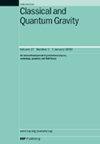Automated alignment of an optical cavity using machine learning
IF 3.6
3区 物理与天体物理
Q2 ASTRONOMY & ASTROPHYSICS
引用次数: 0
Abstract
Optimised alignment is important in optical systems, particularly in high-precision instrumentation such as gravitational wave detectors, in order to maximise the sensitivity. During operations, high performing optical wave-front sensing and feedback systems are used to maintain optical cavity performance. However, the need for an automated initial alignment process arises after maintenance or large environmental disturbances such as earthquakes, as it can be challenging to manually achieve optimised as well as consistent optical alignments. In this study, a machine learning control system is presented to determine the optimal input beam alignment of an optical cavity based on a digital camera stream of the transmitted cavity mode. We use convolutional neural networks to classify the cavity mode from its image, with 100% prediction accuracy for the desired mode. A genetic algorithm is applied to find experimental parameters that maximise the transmitted power of a chosen cavity mode. The system demonstrates consistent alignment outcomes that the median intensity over multiple trials exceeds 95% by the sixth generation of the algorithm. These results show that machine learning techniques can be implemented to automate the alignment process that is compatible for a broad range of optical resonator platforms.求助全文
约1分钟内获得全文
求助全文
来源期刊

Classical and Quantum Gravity
物理-天文与天体物理
CiteScore
7.00
自引率
8.60%
发文量
301
审稿时长
2-4 weeks
期刊介绍:
Classical and Quantum Gravity is an established journal for physicists, mathematicians and cosmologists in the fields of gravitation and the theory of spacetime. The journal is now the acknowledged world leader in classical relativity and all areas of quantum gravity.
 求助内容:
求助内容: 应助结果提醒方式:
应助结果提醒方式:


